Cooking Gas Changes Lives But Comes At Too High A Price
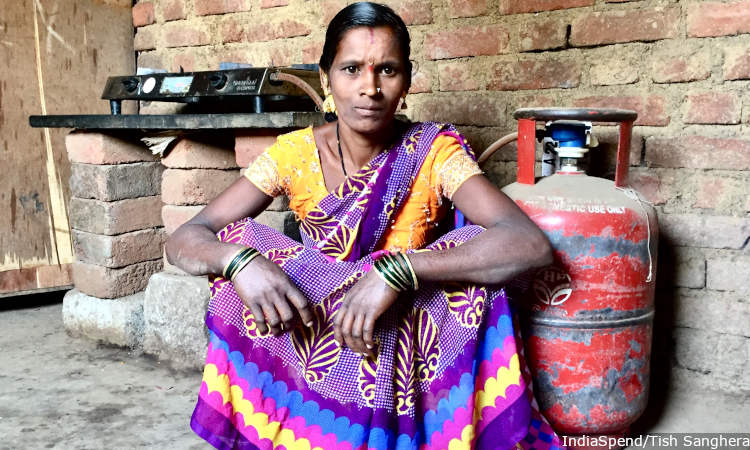
Bharti Patil, a Pradhan Mantri Ujjwala Yojana beneficiary in Tamsai, western Maharashtra. Buying a cylinder, which lasts for 15 days--although she has made it last for up to three months--consumes up to 25% of her monthly household income, so she uses the LPG cylinder once a day.
Mumbai, Thane and West Bengal: Unravelling rolls of brightly coloured paper to adorn the ceiling of her two-room home, Bharti Patil* was busy preparing for her 22 year-old son’s wedding celebrations one recent March morning in Tamsai, a village in Thane district, 98 km north of Mumbai. With much work to be done and guests arriving later in the afternoon, Patil decided that she would cook all the food on her modern stove, using the liquified petroleum gas (LPG) cylinder she received two years ago in July 2017, under the Pradhan Mantri Ujjwala Yojana (PMUY), the Prime Minister’s programme to reach clean cooking gas to 80 million households by 2020.
It was, after all, a special occasion.
“Of course I would prefer to use gas all the time,” said Patil, who uses it once a day. “My eyes sting when the smoke rises from the chulha (traditional wood-fired stove), and it takes time to collect the firewood, but it’s just not possible--sure the bhaji gets cooked fast, but the money runs out fast too.”
As with 85% of PMUY beneficiaries surveyed in Bihar, Uttar Pradesh, Rajasthan and Madhya Pradesh in 2018 by the Research Institute for Compassionate Economics (RICE), a think tank, Patil still uses a chulha. If she were to use LPG for all her cooking and other household tasks, such as heating bathwater and preparing animal feed, the cylinder would empty much faster and topping up the supply be too expensive. So, she and her family continue to breathe in the hazardous fumes that contribute to the 120,000 lives lost each year in India from indoor air pollution.
Though Patil still uses biomass fuels, such as firewood and cow-dung, to cook on her outdoor chulha, the government counts her among the 70 million women whose lives have become “smoke-free”, as the petroleum ministry describes it, after receiving a cooking-gas cylinder under the PMUY.
Launched in 2016, PMUY is one of the National Democratic Alliance (NDA) government’s flagship schemes that aims to reduce the health risks women face from exposure to smoke and time spent in collecting biomass, both significant issues recognised as keeping India’s women unequal, in poor health and burdened with domestic chores.
Pradhan Mantri Ujjwala Yojana has made the kitchens of 7 Crore BPL families smoke-free by providing them clean fuel LPG. #7CrUjjwala #PMUY pic.twitter.com/6YI3uPejCt
— PIB India (@PIB_India) March 8, 2019
A woman who gets an LPG connection under the programme no longer needs biomass as fuel for cooking and lives a ‘smoke-free’ life, according to this Ministry of Petroleum and Natural Gas advertisement for PMUY. Our ground report found that is not the case.
Yet, while the government is on track in terms of providing access to LPG for households officially declared as poor for the first time, raising its target from 50 million to 80 million connections by 2020, it is clear that the immediate problem is ensuring families can fully discard harmful, traditional cooking methods to LPG.
While 90% of poor households now have an LPG connection, an increase of 35 percentage points since 2014, LPG consumption rose by just 0.8% over two years to 2017, despite seeing a 6% increase in customers, Mint reported in June 2017.
The paradox of a growing LPG customer base and slow consumption growth suggests fundamental issues at the heart of the scheme, whose tagline is that, through Ujjwala, or light, “every woman will get her respect and dignity”.
Plagued by an expensive and unhelpful loan system, which withholds the benefits of subsidies, low levels of financial literacy among beneficiaries and fluctuating cylinder prices tied to the international oil market, many women are still far from living “smoke-free” lives, FactChecker found.
This story is the 10th in a series evaluating the government’s flagship programmes.
The first of this series investigated the government’s rural jobs programme (here, here and here); the second discussed the Swachh Bharat (Clean India) Mission’s sewage problem; the third (here, here and here) evaluated the Pradhan Mantri Sahaj Bijli Har Ghar Yojana (Prime Minister’s electricity-to-all-homes programme); the fourth, the fudging of open-defecation-free (ODF) status data and shoddy toilet construction–amid evident enthusiasm and success in increasing toilet access–in Uttar Pradesh, declared ODF on December 31, 2018; the fifth, similar fudging of data and widespread open defecation in Gujarat, declared ODF on October 2, 2017; the sixth explained how the skills-development mission was set to miss deadlines; the seventh probed the failures of the Prime Minister’s crop-insurance programme; the eighth the failure of BharatNet, the project to connect India’s villages to the Internet and the ninth how the mission to clean the river Ganga was failing.
Expensive cylinders, unchanged lives
Only Patil’s husband and father-in-law currently work, supporting the eight-member household on an income of Rs 150 per day each as stone-crushers at the nearby construction site. Last month, they received just 15 days of work. The rural poverty line in Maharashtra is Rs 967 per person per month.
When the family does decide to top up their gas supply, they may spend up to 25% of their monthly income on a 14 kg cylinder refill, which in January 2019 cost them Rs 850. This cost barrier for poor families is why women often end up rationing the gas cylinder’s use, stretching out the fuel source to make it last as long as six months before refilling and why chulhas remain omnipresent.
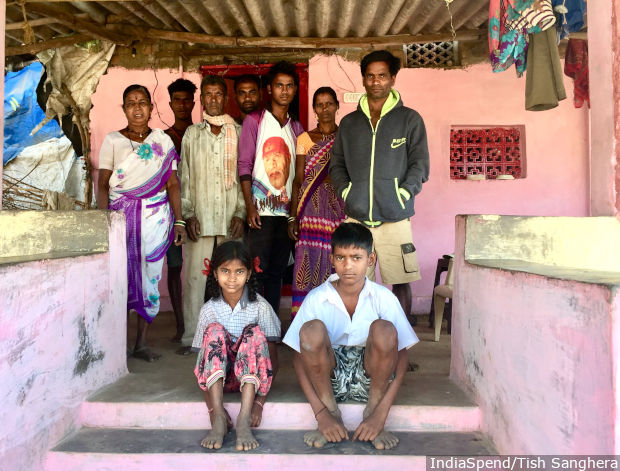
Bharti Patil (second from right) and her family (plus a friend) at their home, before wedding festivities in Tamsai village, western Maharashtra. The eight-person household survives on the father’s and grandfather’s wages of Rs 150 each per day, earnt from stone-crushing. Purchasing an LPG cylinder, which cost them Rs 850 in January 2019, is a considerable expense.
Indeed the scheme’s low refill rate of 3.28 cylinders per capita in 2019 points to the difficulty families face in making regular use of the new LPG connections. While the government waives the connection fee of Rs 1,600, and provides a loan to cover the cost of the stove and first cylinder (around Rs 1,800), families must still pay anywhere between Rs 700-900 once the first cylinder runs out--a significant amount for those living close to the international poverty line ($1.90 or Rs 130 per day, which is 21% of Indians).
With the price of LPG gas cylinders tied to the fluctuations of the international fuel market, PMUY beneficiaries must weather price increases. Villagers in Paschim Medinipur District, West Bengal told FactChecker in November 2018 that the price of a refill rose to over Rs 900.
“This is a problem because we are very needy people, every time the price increases from Rs 500, Rs 600 to even Rs 700 and beyond, it is very distressing,” Mithu Jana, 32, told FactChecker. “Do you think it is possible for us to afford the cylinder if it goes beyond Rs 1,000? If it does, then I think I will just have to stop using it so often, or just stop buying it all actually.”
Jana said even now when the refill needed to be bought, she would often buy fewer fish and eggs that week, reducing her grocery expenditure from Rs 100 to Rs 60. Indeed, researchers have found that up to 51% of PMUY households would have to either reduce or stop using LPG altogether if faced with a price hike of between Rs 300-400 per cylinder.
As rice farmers, Jana and her community collect piles of leftover straw in the harvest months to feed into their outdoor stoves through the year. They also buy firewood for Rs 5 per bundle, which lasts about eight days, making the switch to LPG an expensive one amidst free and low-cost alternatives.
The abundance of firewood in Chhattisgarh, where up to 41% of the land is forest, likely explained why beneficiaries in that state consumed, on average, no more than 2.7 refills per year, compared to 3.8 in Madhya Pradesh and 3.2 in Uttar Pradesh, where forest cover is significantly less, according to a 2018 study by MicroSave, a consultancy.

Firewood stacked in Tamsai village, Thane district, Maharashtra. Though the forest department limits the times of the year when wood can be collected, the villagers tell us that the supply is generally good and a low-cost alternative to LPG cylinders.
Currently, over 70 million women have a connection under the scheme, according to official government data. The women we spoke to said their lives had not significantly changed with the advent of the LPG connection. Many still breathe in chulha smoke daily and collect or purchase firewood and dung cakes to plug the energy gap. Several women we spoke to across two states said that a cylinder priced between Rs 200-300 would be most affordable.
For those paid irregularly or in lump sums, managing other household expenses alongside the cylinder cost can be tough. After two months working on a construction job, Bhano Durga’s husband received Rs 5,000 and her sons’ 10th standard school and exam fees totalling Rs 1,100 were first to be paid. “So then, given all this, buying a cylinder becomes really expensive,” said Durga, 33, from Tamsai, Maharashtra. “They should help us and lower the price.”
Providing access to LPG cylinders in every home could help increase poor women’s economic productivity and reduce the drudgery of their domestic chores, of which India’s poor women spend the most time on globally, IndiaSpend reported in March 2019. However, many women we spoke to scoffed at the idea that by cooking with LPG, they may have more time or the ability to take up home-based, self-employment such as tailoring, as this 2019 ministry of petroleum and natural gas report suggested.
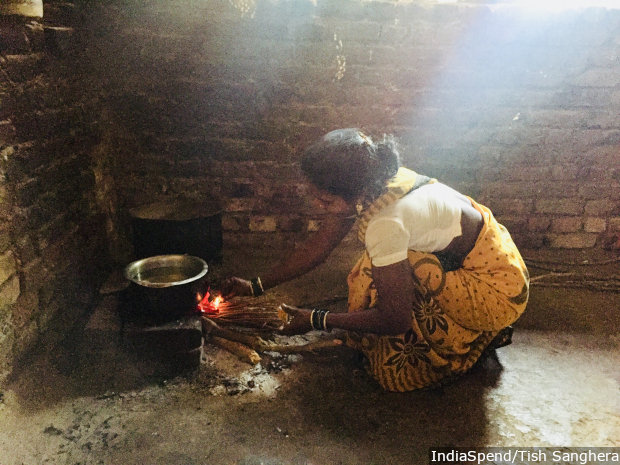
Bhano Durga, 33, lights her chulha in the covered and poorly-ventilated corner of her home that she uses as a kitchen in Tamsai, western Maharashtra. Exposure to indoor air pollution kills 120,000 Indians every year.
“Why doesn’t the government create jobs for us, rather than asking us to find something for ourselves?” Jana told FactChecker. “They haven’t left any opportunities for us here, we are all unemployed.” Jana added that any time she saves from cooking on the chulha doesn’t really matter in the long-run. “All my saved time goes to looking after the children, I don’t really do anything else.”
The unequal burden of cooking, cleaning and fuel collecting that Indian women bear is a reason why cooking on traditional stoves may not end soon, experts have suggested. Until women’s time and availability is seen as a productive economic contribution and while 73% continue to be out of the workforce, a “low opportunity cost” will be attached to switching to LPG usage full-time, said a 2019 RICE study. While the PMUY has obvious benefits for women, advertisements for the scheme emphasising these benefits also “reinforce women’s roles as cooks”, said the RICE study, which argued that promoting gender equality in household tasks and promoting men’s involvement could further help accelerate the use of LPG.
The EMI problem
Under PMUY, beneficiaries can cover the cost of the stove and first cylinder (roughly Rs 1,800) with an interest-free loan paid to the oil marketing company (OMC) through an equated monthly instalment (EMI) process. The first instalment is paid when purchasing the first refill. Instead of beneficiaries receiving the government subsidy (usually worth between Rs 200-300) through direct benefit transfer (DBT), into their bank accounts, the subsidy is instead redirected to the OMC and beneficiaries pay the standard market rate.
Since it can take anywhere between six and ten refill purchases to repay the loan, PMUY beneficiaries are no different from regular, non-Ujjwala LPG consumers for this period and experience little benefit while having to pay the market rate. This is a “structural” flaw in the scheme’s design and a key reason why poor families are unable to sustain their cylinder use, according to this 2018 article in the Economic & Political Weekly.
"From a design perspective, if the purpose of Ujjwala is to help beneficiaries use LPG and tackle the issue of affordability, it’s odd that households who take out loans under Ujjwala end up paying more for refills than other beneficiaries,” Chris Beaton, senior policy advisor and lead, India program at the International Institute for Sustainable Development, a think tank, told FactChecker. “Even if for a limited period”.
“It seems that this design doesn’t fit with the purpose of the policy,” said Beaton. “Based on our research, these higher costs of refills do affect household decisions on which fuel and how much fuel to purchase”.
Indeed, this system where loan repayments are attached to refills is why some beneficiaries have been dropping out, said Pradip Samanto, manager at an Indane gas agency in Panksura, West Bengal. While PMUY has brought them 7,000 of their 26,500 customers, many are purchasing few refills, between three to four per year.
“They are offered the connection at a subsidised rate, and so [they] take it, but the refills are always going to be a problem,” he said. “Many don’t understand how the loan works and that after repaying it, the subsidy will begin to kick in and the refill price will come down. Some people, therefore, drop out.”
In March 2018, Indian Oil decided to offer deferred loan payments after the first six refills. The idea was that consumers would become accustomed to using LPG cylinders and be more willing to buy a costlier cylinder when the time to start making loan payments comes. However, some are also unsure of this strategy’s merits believing that it may just delay the problem, rather than solving it.
Some OMCs may also be concerned about not ever recovering the loan if payments are delayed. “We used to offer this facility, but now payments are back to taking place from the first one,” Nikhil Edwankar, 33, owner of Hindustan Petroleum’s Shreeram Gas Agency in Manor, Thane District, Maharashtra, told FactChecker. “We stopped this because customers were not willing to take the refill.”
Edwankar said customers were reluctant to buy the refill not because they did not have money but because cooking fuel was not a family priority. “People do have the money here actually, they could be buying more cylinders regularly if they wanted to,” he said, “It’s just awareness.”
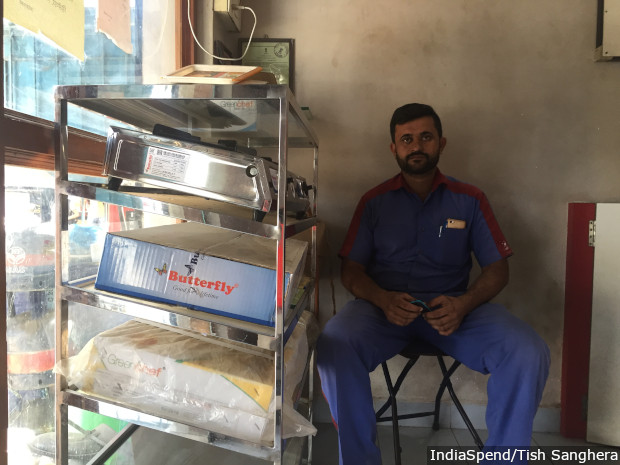
An employee of the Shreeram Gas Agency, in Manor, a village in Thane district, Maharashtra. He sits beside a stack of stoves that are offered as part of an interest-free loan, in addition to the first LPG cylinder, which is free, under the Pradhan Mantri Ujjwala Yojana scheme.
However, a credit mechanism offering some sort of protection against fluctuating cylinder costs and the irregular income of many rural workers, who are often paid sporadically and in lump sums, would be welcomed by some, including Patil’s husband. “Only rich people can get goods on credit,” he said, downcast, kicking his feet in the dust. “For people like us, that’s never an option. If we don’t have the money for a refill, we have to wait until we do, and that can take time.”
Several of the villagers we spoke to in both Maharashtra and West Bengal were also unaware of a loan to finance the stove and cylinder; they had paid an upfront fee of up to Rs 2,000, in some cases. “I borrowed money from someone in the village to get my connection since I didn’t want to miss out when [the gas dealer] came and signed everyone up,” said Mamoni Dinda, 29. “If I had known there is an option to take out a loan, I would have definitely gone for that.”
Dinda’s experience was not uncommon, we found, and added to the substantial confusion that appeared to surround the scheme. Many beneficiaries were dismayed that while, for the first time, they had cooking gas at home, something they previously did not think possible, continued use of LPG still involved paying large sums up front. Due to low levels of financial literacy, many were unsure if they were receiving the subsidy each time they purchased a refill, or claimed that nothing had been deposited in their accounts.
“While DBT improves the efficiency of the subsidy delivery, it also could hinder sustained use of the LPG for low-income households in rural areas,” said Abhishek Jain, senior programme lead at the Council on Energy, Environment and Water (CEEW), a think tank
“Digital money has not penetrated rural India so far, plus access to ATMs and bank branches is not easy for rural customers,” said Jain, meaning that even if subsidies are landing in people’s accounts, households are still making refilling decisions based on “out-of-pocket expenditure and not the subsidised price”.
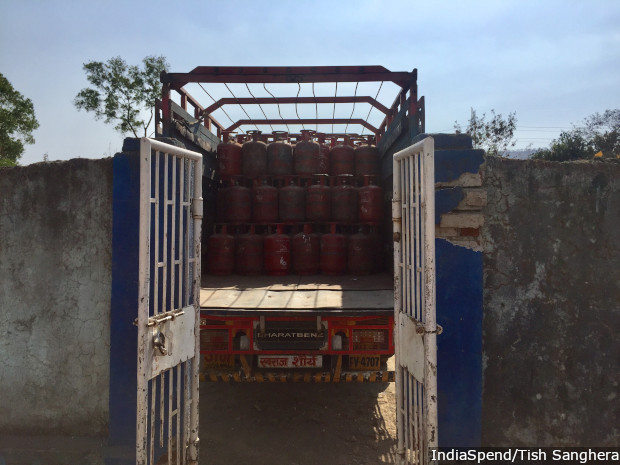
A Hindustan Petroleum truck filled with LPG cylinders prepares to leave a depot outside Manor, a village in Thane district, Maharashtra.
Removing economic barriers to sustained LPG use is an important way of helping women convert to clean cooking fuels, since awareness around the adverse health effects brought about by inhaling smoke is unlikely to alone spur the move. Only a few of the women interviewed across 514 households in Chhattisgarh, Madhya Pradesh and Uttar Pradesh identified health as a major concern; cooking on the chulha was justified if it saved money.
A solution to high up-front fees could be financing from microfinance institutions (MFIs), self-help groups (SHGs) and small finance banks for PMUY beneficiaries, said Anurodh Giri, associate partner in government and social impact division at MicroSave.
“PMUY customers perceive LPG to be more expensive than fuelwood and cow dung and find the refill unaffordable,” said Giri. “For instance, the MFI channel can be used to extend credit to PMUY beneficiaries who are existing MFI customers. Similarly, SHG members who hold a PMUY connection should be provided a financial solution to save for refills every day or every week for LPG.”
Well-intentioned, but is it sustainable?
While the petroleum ministry provides a national average for LPG cylinder consumption, the paucity of official state-wise data and absence of district and village level data (as are available for other government schemes) has been criticised as a roadblock to assess the scheme’s sustainability.
Since 98% of PMUY beneficiaries still have a chulha at home and up to 37% regularly mix their usage of biomass cooking and LPG cylinder cooking regularly, experts have called for more detailed and regular data on refills to directly measure the extent to which LPG is being used.
Simply providing a national average for refills is not enough, said Beaton, who believed an overall figure “doesn’t provide very granular data for understanding LPG affordability in different parts of the country”. He added that “these energy subsidies are very expensive and among the largest in India, so it's important to have transparent data and ongoing evaluation so they can continue to be refined and improved”.
The difference in cylinder consumption nationwide was recently revealed in the answer to a Lok Sabha question in February 2019, where unverified data collected by OMCs were given. While some states, such as Haryana and Sikkim, recorded higher than the national average of 3.4 per capita cylinder consumption in 2017-18, at 5.6 and 5.2 respectively, some states were considerably lower, such as Chhattisgarh (1.7) and Assam (2.9). Some states had also seen a decrease in the average number of refills between 2016-17 and 2017-18, such as Uttar Pradesh and Rajasthan.
Source: Lok Sabha
What is clear is that between 2016-17, $3.2 billion was paid out in LPG subsidies to not just the poorest Indians under PMUY but also richer and more affluent middle-class households. This figure, which has likely since increased, as PMUY’s net has been cast wider and connections have increased, has led to suggestions that the government’s overall targeting for LPG subsidies must be improved, in order to drive down an already expensive policy. Indeed, just 48% of the PMUY beneficiaries were found to be among the poorest 40% of households, according to this 2019 study.
“Almost every household in the country is receiving the same subsidy, irrespective of income and household size,” Jain said. “We need to rationalise subsidies and target them better. Most middle-income and well-to-do households don’t actually need subsidy and can afford LPG at market price. This would be the only way to limit ballooning subsidy expenditure."
The government has previously tried to scale back its subsidy expenditure on LPG through various means, such as the “Give It Up” campaign in 2015, which saw over 10 million middle-class households voluntarily surrender subsidies. That was a “remarkable example of behavioural economics used in policy-making”, says Jain. A mandatory subscription of taxpayers earning above Rs 100,000 per year from consumer subsidies was another similar move. However, that could only have a limited effect, given that, at most, 4.5% of Indians are estimated to pay taxes.
Combined with non-PMUY customers, the LPG consumer base has now grown to cover 90% of households, significantly increasing India’s reliance on LPG as a fuel source. India’s LPG consumption, though, is higher than domestic production, leading to a trade deficit of $5.5 billion, or 6.5% of India’s total in 2017-18. This could pose a problem for the country’s foreign exchange reserves and lead to fuel insecurity, said Beaton.
“It's easy for LPG subsidies to quickly become more expensive if world prices rise, which will also affect India's trade balance,” said Beaton. “Policies like PMUY, which increase the number of consumers, add to this risk.”
Beaton went on to add that as the second biggest importer of LPG globally, India is “exposed” if prices go up, which is “quite feasible, given limited global supply and the number of countries that are seeking to promote LPG”.
Up to 90% of India’s LPG supply is imported from the Middle East, including Saudi Arabia and Qatar. This means geopolitical shocks could lead to a rise in the price of imports, as happened in November 2017. This could also have a significant impact on government finances and is another important consideration for the long-term suitability of the scheme and LPG subsidies.
While LPG is viewed by experts “an important pillar of India’s strategy to achieve universal access to clean cooking”, said Beaton, “it also makes sense to promote a diversified approach to this problem." Given the not-insignificant economic burden of LPG imports, the government could look instead to increase the coverage of clean, non-fossil cooking fuels as per the National Mission on Clean Cooking Energy.
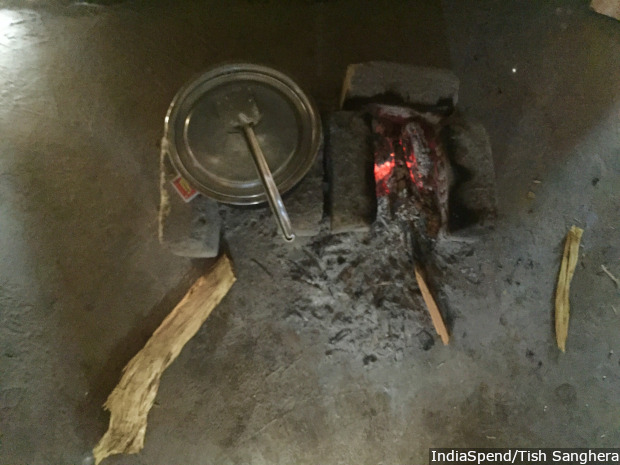
A stove using firewood as its energy source, a non-clean cooking fuel that contributes to excessive levels of indoor air pollution.
Part of the draft National Energy Plan, the mission aims to establish nationwide clean-cooking coverage by 2022 but it has been sidelined, as resources are directed toward the push for LPG, according to this 2019 study by the International Network on Gender and Sustainability, a policy research group.
Jain pointed to improved cook-stoves as a potential replacement of biomass fuel. These stoves are currently being tested in Bangladesh and Africa but not in India.
“Right now we’re not alleviating the public-health issue, which is still prevalent when using biomass even once a day,” said Jain. “So, if households continue to use traditional biomass along with LPG, we need to think about providing other cleaner-cooking solutions, to ensure the entire cooking stack in the household is clean.”
This story is part of “Modi’s Report Card”, a series evaluating flagship government programmes in the run up to the 2019 general elections. You can read a set of stories on the rural jobs programme here, here and here; on the rural electrification programme here, here and here; on Swachh Bharat Mission here, here and here; the skills-development mission here; the crop-insurance scheme here ;the digital empowerment of villages here and cleaning the Ganga here.
*Name changed on request.
(Sanghera is a writer and researcher with IndiaSpend.)
We welcome feedback. Please write to respond@indiaspend.org. We reserve the right to edit responses for language and grammar.


